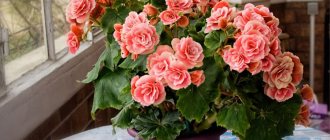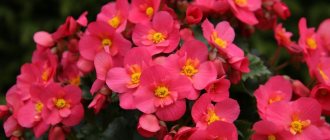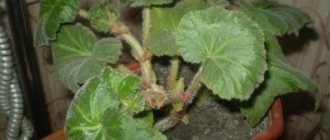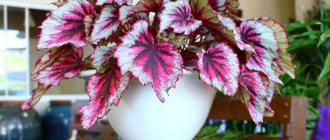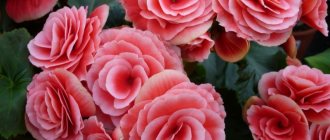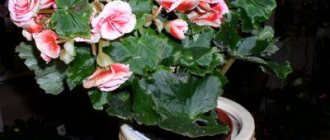The beautiful begonia comes from Haiti, and received its name in honor of Governor Michel Begon.
The flowering begonia, which is quite easy to care for, is a truly delightful plant, fragrant and with colorful inflorescences. Begonia will decorate not only a greenhouse or garden, but also takes root well in indoor conditions.
The “calling card” of begonia, for which many gardeners love it, is an asymmetrical beveled leaf combined with smooth waves of edges and serration. The upper part of the leaf is green, the lower part is a rich brown-violet color. Strong and dense stems protect against pests. In ancient times, begonia was even used to polish swords and armor.
Begonia inflorescences amaze with their versatility of color and rich, uniform color with a piquant edging on the petals. Begonia bears fruit in peculiar “boxes”. Their bizarre shape with thin walls was created by nature for ease of sowing and propagation of plants - one breath of wind and the fruit opens, scattering seeds for the maturation of new seedlings.
General rules for caring for begonias at home after purchase
For the begonia flower, care at home includes a basic requirement - the main thing is to choose a place in the house for the new resident and adhere to simple rules:
- place a pot with a plant, focusing on the east-west sides in winter, and in summer it is preferable to choose the northern corner;
- avoid drafts;
- do not place in close proximity to other plants, so as not to shade the young seedlings;
- let it get used to the new room - do not replant, water or move from one place to another for the first week from the date of purchase.
Home adaptation: 4 rules
Caring for begonias after purchase has some nuances. Inexperienced flower growers, not knowing about them, make mistakes that can lead to the death of the “pet”. This is how myths arise that tropical flowers (including begonias) are not suitable for window sills. If you follow four rules, the plant will delight you with rapid growth and lush flowering.
- We choose a place. Whether the flower will take root in its new home or not depends on the right location. If begonia appeared in the apartment in the autumn-winter period, it is better to place the flowerpot on a western or eastern window. If you bought a begonia in spring or summer, place it on a windowsill facing north. Under the scorching sun, the leaves of a plant that came into the house from a greenhouse turn yellow. During the acclimatization period, drafts are especially dangerous: try to exclude them.
- We don't water. The first five days after purchase there is no need to water. Let the plant adapt to new conditions. If you are afraid that the flower will not have enough moisture, place a container of water near the flowerpot. When the adaptation time has passed, evaluate the condition of the earthen clod: if it is dry, then water it.
- We don't replant. Immediately after purchase, you should not replant the tropical beauty. Especially if she came into the house already in bloom. Emergency replanting is necessary only when it is clear that the flower is flooded or the condition of the soil in the pot is in doubt.
- We observe quarantine. It is important to wait two weeks for quarantine and only then put a new plant in your window sill greenhouse. Quarantine has two purposes. First: do not infect old plants if the begonia “brought” insects into the house. Second: to prevent infection of the begonia itself, for which “moving” is stressful - a weakened plant will not cope with new difficulties.
It can be difficult to immediately decide on a place. In search of the ideal location, the flower owner begins to rearrange the flowerpot. Begonia doesn't like this. If she has not yet had time to adapt to the new home, then she may even begin to wither away from the changes.
Lighting
Light-loving indoor begonia flowers tolerate changes very capriciously; the plant does not tolerate direct sunlight. In the hot summer, care should be taken not only about sufficient lighting, but also about protection from excessive insolation. Plants feel optimally comfortable on the eastern or western windows of the house, being on the south side. Owners of the plant should take care of shading at midday to avoid burning the delicate cover of the flower.
In winter, begonias go into a dormant state, with the exception of ever-flowering species, but even those need maximum lighting. It doesn’t matter whether it is natural or artificial light, the flower must be provided with at least 14-hour light baths.
In the shade, with sufficient feeding, begonia grows, but does not bloom. Also, with excessive darkening, the flower suffers and changes - the shoots stretch out and flowering stops completely. If you are wondering why begonia does not bloom at home, perhaps it does not receive the necessary dose of light.
Types and varieties of begonia
After the discovery of Begonia by Michel Begon, “relatives” of the plant were found in Brazil, Indonesia, as well as a tuberous subspecies in South America. Modern varieties originated from them. Today there are a huge number of hybrids and cultivars of plants.
They are divided into groups:
- Decorative flowering.
- Decorative deciduous.
Tuberous begonia is considered the most popular because it is easy to care for and boasts a rich palette of shades. The plant's favorite climate is subtropics and tropics. It prefers shady and humid places, which are widespread in these latitudes. But there are species that grow well and spread on steep seashores, in mountains and arid slopes.
Begonia is diverse not only in shape, but also in size and color. Some species are low herbaceous plants, while others grow to the size of medium-sized shrubs. The leaves may have an incredible color, unusual in nature, or be covered with spots or bizarre patterns, which is considered quite normal for this plant.
You may be interested in:
Storing tuberous begonias at home in winter: preparation and care features Gardeners grow many plants in their garden plots. Among them there are heat-loving crops,...Read more...
Popular types of begonia:
- Decorative foliage. This flower does not have a stem - its leaves grow directly from the rhizome. Thanks to the varied colors of the “crown”, this look fits perfectly into any interior. Popular representatives of this family are “Royal Begonia” and “Cleopatra Begonia”.
- Bush. The appearance of the stems of this plant is similar to bamboo. It grows up to 2 meters in height and blooms all year round. Often in homes you can find “Coral Begonia” and “Fuchsia Begonia”.
- Tuberous. Begonia gets its name from its tuberous root. The stems of the plant can reach up to 80 cm. The flowers are double and simple, similar to roses or carnations, with a diameter of 3 to 20 cm. The heart-shaped leaves can be matte, glossy flat or corrugated. The color of the leaves of the plant ranges from light green to dark. Tuberous begonia blooms from May to October.
- Ever-blooming. This type of begonia can often be seen in city flower beds. At home, evergreen begonias bloom all year round. The leaves are glossy, green or brown. The flowers are small, red, pink, white.
- Royal. Decorative deciduous begonia. It is distinguished by large leaves up to 30 cm, painted in different shades of green, brown and red. The leaf blades can be heart-shaped or resemble a spiral.
- Ampelnaya. It is a subspecies of tuberous begonia. Planted for vertical gardening. The length of the shoots is from 25 to 50 cm. The plant is literally strewn with flowers of crimson, orange, yellow, and white.
- Elatior. The tuberous begonia hybrid is intended for growing indoors. The shoots are thin, with a red tint, and need support. Flowers appear in autumn and winter. The foliage is glossy, round in shape. Flowers are 5 cm in diameter, painted white, yellow, and red.
Many people grow begonia at home, photos of which show all the beauty of this plant. But still, some people often wonder whether it is possible to keep it at home and how to properly care for the flower.
Humidity
In the wild, the flower grows in the warm and humid climate of tropical forests with a saturation of the atmosphere around moisture of at least 60-70%. Houseplants do not lag behind their ancestors and prefer intensive watering and external irrigation of the air around them with clean water. It is important to note that it is not recommended to spray the plant itself, since drops of water adversely affect the surface of the leaves and stem, leaving stains and changing the natural color.
For the convenience of the owners, you can place the plants on pallets with wet expanded clay, provided that the begonia pot is provided with drainage. Bush begonia, care for which at home requires creating an optimal microclimate through the use of special devices - you can use a humidifier for indoor spaces or use the folk method - place a container of water next to the pot and keep it away from the central heating elements.
If the microclimate is too dry, you can observe drying of the edges of the leaves, wilting of the buds, changes in color and roughness. Begonia in a pot requires careful care at home, otherwise it simply loses its decorative effect.
Proper care of begonias at home to maintain moisture includes:
- in summer, water abundantly every other day or once every three days;
- for begonias, winter care at home includes watering the soil when the top layer dries 1.5-2 cm or once every 10 days;
- every 10-14 days it is necessary to add complex fertilizer to the water for irrigation;
- do not allow water to stagnate in the trays to avoid rotting of the roots;
- You can water only with clean water at room temperature that has been standing for 2-4 days.
Replanting correctly
Begonia is replanted when the pot becomes small, if the soil is in doubt, after overwatering and to stimulate flowering. A tropical plant needs loose, breathable soil so that the water does not stagnate and the roots do not rot. The composition of the soil is difficult to choose on your own, especially for novice gardeners. It’s better to buy a specialized substrate in the store. Moreover, each species requires its own soil - with a certain acidity.
What you will need:
- drainage;
- priming;
- pot with drainage holes and tray.
Instructions
- Take a pot about 3 cm wider than the one in which the begonia is growing.
- Place drainage at the bottom. Layer - at least 2 cm.
- Remove the plant from its previous pot. Carefully free the roots from the old soil.
- Place in a new pot, cover with store-bought substrate.
Begonia can be replanted in universal soil for flowering crops or in a mixture for violets. A prerequisite is that the base must be peat. If you understand that the soil is not loose enough, use “raising agents” - perlite or sphagnum moss. It’s better not to get carried away with “baking powder”: a couple of spoons are enough (guide by the size of the flowerpot).
Transfer
When looking for answers on how to replant or how to grow tuberous begonia at home, you should pay attention to the instructions indicated on the label upon purchase, or consult with experienced flower gardeners on all the nuances of replanting and growing plants.
Is it possible to replant flowering begonia at home? Flowering or non-flowering plants require the same care. They can be replanted for further cultivation in slightly acidic soil, with good air circulation and water permeability. The optimal composition of the mixture for replanting includes 2 parts humus soil, 1 part high-moor peat, 1 part coarse sand.
For transplantation, it is important to take into account the structure of the root system - tuberous, rhizome or root. Tuberous begonia is unpretentious in planting and caring for at home. Rhizome and root require a more careful selection of containers with excellent drainage layer, but it is also important to take into account the fragility of the roots to fracture and, if possible, do not roughly clean them, but transfer them to a new pot with the addition of the mixture on top of the roots of the plant.
Is it possible to replant a flowering begonia after purchasing it in a store at home? Of course yes, especially if you doubt the quality of the soil or notice excess moisture in the pan.
Most of the roots are located in the surface layer and it is better to choose a pot with a wide diameter rather than rely on height indicators. Fertilizer for flowering begonia at home can be purchased specially or prepared independently by adding nutrients to the water for irrigation once every two weeks.
How are flowers kept in stores?
Often, potted crops in stores are sold in bloom. Flowering takes a lot of energy and plants need fertilizing. Transport soil, as a rule, does not contain nutrients and is needed only for the development of the root system, so the viability of plants is maintained by watering with fertilizer solutions. Store lighting is usually insufficient.
The begonias do not have time to die or become deformed while they are on the counter, but the plant still manages to get used to the small amount of light and will need some time to adapt to return to the normal light regime.
Reproduction
For begonia, tuberous planting and care in open ground and at home are different. For open ground and greenhouses, a more careful selection of the mineral composition, protection of new seedlings from pests, preparation of greenhouse conditions for the germination of new seeds, and allocation of land for growing cuttings are required. At the same time, propagation of begonia by cuttings at home does not require large financial costs and less demanding loose soil and watering are suitable.
Reproduction of begonia can be carried out in several ways - using seeds, propagation of tuberous begonia by cuttings of leaves and stems, by dividing the bush and tubers.
The advantage of cuttings, undoubtedly, is the rapid growth of new plants while maintaining varietal characteristics. It is optimal to propagate begonias by cuttings in the spring, when the greatest growth and development of the plant begins.
Let's take a closer look at how to grow begonia from cuttings:
- young shoots are cut from the top, removing flowers and buds, trimming the lower leaves for ease of planting, and the upper leaves are shortened to reduce evaporation from the young seedling;
- begonias require thinking through all the details, so cuttings are planted in greenhouses, covered with cellophane or glass, with good moisture drainage;
- The cuttings are planted in a special peat-sand-verimculite mixture, regularly ventilated and watered, avoiding rotting or excessive solar radiation.
Begonia can be propagated by leaves at home by rooting in water, but the main thing is to select young leaves, 3 cm long. They begin to feed only a month after transplantation.
Dividing the tubers and the bush is suitable for tuberous begonia, growing and caring for it, as well as for plants that form large bushes. The main advantage is that such begonias begin to bloom earlier and their flowering period lasts longer. To propagate tubers, the plants along with the earthen ball are replanted entirely, without cleaning the roots. To form new roots, tubers need good access to air and semi-moist soil, but do not overdo it with watering, as there is a high risk of tubers rotting and plant death.
It is possible to grow begonia from seeds at home for some varieties, namely: for ever-flowering varieties of begonias, tuberous plants, and also excellent for the species ampelous begonia, for which care is especially demanding. Seeds are produced in large quantities and allow you to immediately obtain a large number of beautiful begonias in a short period of time.
Propagation by ridiculing seeds is used for large greenhouses and open areas; at home, it is more advisable to use cuttings or dividing tubers.
How to grow begonia from seeds at home? It's simple. A mixture of compost, leaf soil, peat and sand is poured into shallow containers and watered with foundation sol to prevent fungal infections. Cover with transparent glass or plastic film, placing the seedlings in a warm, bright place. Caring for begonia in a pot after the leaves appear and replanting does not require watering, temperature conditions or a sufficient amount of sunbathing.
Care
Watering
Begonia does not tolerate too wet soil. Overmoistening is especially dangerous for tender seedlings; plants “suffocate” from lack of air and may die from root rot. The substrate should be moist, but not wet. Watering with cold water below 12°C should be avoided to prevent the roots from dying off. During the flowering period, begonias should not experience a lack of moisture, otherwise the leaves will lose their decorative effect, and the buds and flowers will begin to fall off.
These plants have a delicate root system that is sensitive to overdose of fertilizers and improper watering. From spring to autumn, begonias are watered abundantly, after the top layer of soil has dried. Once every 10 days, complex fertilizers are added to the water for irrigation. In autumn and winter, they are transferred to moderate watering, preventing the earthen clod from completely drying out. Excess or lack of moisture leads to the fall of leaves and buds, and can cause various diseases and even the death of the plant.
Top dressing
For normal growth and development, plants need balanced nutrition. When feeding, seasonality, the age of the plant, and its characteristics are taken into account. During spring growth, plants need nitrogen. With its deficiency, begonias lag behind in development, the leaves become pale green. With an excess of nitrogen, plants do not adapt well to unfavorable conditions.
From mid-summer, flowers are prepared for the autumn-winter period. In fertilizers, the amount of nitrogen is reduced and the proportion of phosphorus and potassium is increased. Organic and mineral fertilizers are used for fertilizing. Frequency – once every 10-14 days. Do not feed sick or dry plants.
Transfer
Royal begonia (Begonia rex)
Begonias can be replanted throughout the spring, or at least until mid-summer, so that the plants have time to get stronger by autumn. This procedure is carried out annually, sometimes twice a year if the bushes and roots have grown quickly and the pot has become cramped. There is no need to take a new container that is too large. The begonia roots should fill the entire volume of the pot, so it is better that the new pot is not much larger than the previous one.
Begonias are watered before transplanting. The soil should not be too wet. In a new pot, a layer of expanded clay is placed on the bottom for drainage, then the flower is transferred along with a lump of earth. If necessary, add soil to the container and compact it around. Transplantation can be combined with dividing the plant. An important point when planting tubers is that they should not be planted too deeply. This will negatively affect flowering, the bush will be lush and flowering will be sparse.
Features of care in winter
Wintering conditions for different species have their own characteristics, for some it is a period of relative rest, while others need a full winter rest. Watering and room temperature are important factors for keeping plants during the cold season.
Plants with decorative leaves can develop in the same way in winter as in summer. But in conditions of short daylight hours and a lack of natural light, the shoots stretch out, become thin and fragile. Plant growth is regulated by watering. In winter, it is reduced and watered when the top layer of soil dries out. The temperature is also reduced to 16-18°C. You cannot place pots of flowers near heating appliances and radiators. It is advisable to provide additional lighting for the flowers.
Elatior begonias have a year-round development cycle; they can delight you with their flowering all winter long. To make it lush, artificial lighting is provided for 14 hours of daylight. Watering should not be excessive. Experienced flower growers still advise giving Elatior begonias a rest between winter blooms. By pinching the tips of the shoots you can regulate the flowering time.
For tuberous begonias, after the end of summer flowering, reduce watering, cut off the shoots and move the pots to a cool place - to the basement, glassed-in loggia, veranda.
Tubers can be preserved in another way . At the end of September, after pruning, they are removed from the ground, cleaned, dried, placed in a bag of peat and placed in winter storage. The tubers will remain dormant until the end of winter. The tubers are checked regularly, at least 1–2 times a month. When root rot appears, the affected areas are cleaned and then treated with sulfur. If the infection has spread to large areas, the tuber is thrown away to save other plants.
It is not advisable to store tubers in the refrigerator; it is too cold for them. The buds will take a long time to wake up in the spring.
Pests and diseases
Begonia diseases occur due to improper care at home. They include damp mold, powdery mildew, black-brown bacterial mold, cucumber mosaic virus, and vascular bacteriosis. The most common diseases that affect flowers are gray rot and powdery mildew.
Pests include red spider mites, greenhouse aphids, greenhouse whiteflies, spider mites, soft scale insects, leaf and root-knot nematodes, and greenhouse thrips. Begonia is not affected by many diseases, but it is important to carry out timely treatment to prevent the death of the flower.
Indoor begonia will give comfort and introduce a tropical flavor of warm countries, will amaze with its variety of colors and will delight its owners for a long time if it is provided with proper care.
| Growing | Begonias are heat-loving and do not tolerate negative temperatures. Temperature balance: in summer the room should be between 20-25°C, in winter – 16-18°C. Avoid direct sunlight. |
| Humidity | Requires constant spraying and abundant watering when the top layer of soil dries out. With a lack of nutrition and moisture, double flowers become simple. It is better to place plants on pallets with wet expanded clay. |
| Feeding and pruning | During budding or flowering, feed 2 times a month with complex mineral fertilizers. Young plants are pruned for the first time when the stems are 6-7 centimeters long. |
| Flowering period | It blooms in early spring and continues to bloom until late autumn. Some varieties bloom in winter, but most bloom between June and September. |
| Landing, transplant | It does not require frequent replanting; after purchase, it is recommended to change the soil composition to highly fertile, loose and moisture-absorbing soil. It is optimal to transplant annually in the spring, after a dormant period. |
| Reproduction | Begonia is propagated by seeds, leaf and stem cuttings, and dividing tubers and bushes. |
| Pests | Greenhouse aphid, greenhouse whitefly, spider mite, soft scale insect, leaf and root-knot nematode, greenhouse thrips. |
| Diseases | Powdery mildew, gray rot, bacterial spot, ring spot, black root rot, vascular bacteriosis. |
How to plant begonia
Planting evergreen begonia at home is a troublesome task. But despite this, loving owners cope with this task perfectly.
Even a beginner can transplant a begonia if he takes into account the following recommendations:
- Begonia tubers are usually planted at the end of February or March.
- Before planting, it is advisable to soak it in epin or another growth stimulant for a couple of hours. You can treat it with a fungicide or keep it in a weak solution of potassium permanganate to protect it from rotting.
- A small depression is made in the soil, into which the tuber is placed with its growing points upward.
- Do not sprinkle soil on top until the sprouts reach a size of 4-5cm. Thin, delicate roots appear on the lower convex side of the tuber.
For what diseases can flowers not be treated?
In addition to the listed lesions of cucumber mosaic, tomato spot, nematode, flowers do not save against bacterial wilt. Signs: curling, dropping leaves, formation of dry spots on the plate, basal gray rot. The flower is thrown away along with the soil and pot. They do this as quickly as possible so that the disease does not spread to other indoor flowers.
If it is a pity to throw away the pot, it is thoroughly washed with a disinfectant, boiled or burned in the oven. Then they are washed again with a manganese solution, rinsed and dried.
